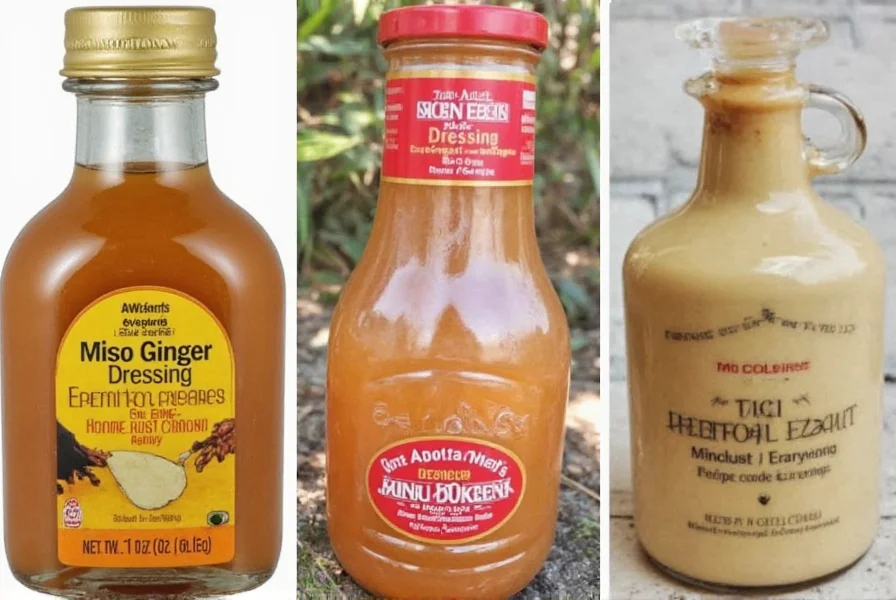For home cooks seeking to elevate their salad game, miso ginger dressing offers a sophisticated alternative to conventional vinaigrettes. This Japanese-inspired condiment has gained popularity in Western kitchens for its complex flavor profile that bridges sweet, salty, and umami notes. Unlike store-bought options that often contain preservatives and excessive sugar, homemade miso ginger dressing allows complete control over ingredients and flavor balance.
The Science Behind Miso Ginger Dressing's Versatility
Miso paste, the foundation of this dressing, contains naturally occurring glutamates that enhance savory flavors—a phenomenon known as umami. When combined with fresh ginger's zesty warmth and rice vinegar's mild acidity, the resulting dressing creates a harmonious balance that works across diverse salad compositions. The enzymatic properties of raw ginger also help break down bitter compounds in certain greens, making previously unpalatable vegetables more enjoyable.
Essential Components of Authentic Miso Ginger Dressing
Understanding each ingredient's role ensures consistent results when preparing homemade miso ginger salad dressing. Quality ingredients make a significant difference in the final product:
| Ingredient | Varieties | Flavor Contribution | Recommended Proportion |
|---|---|---|---|
| Miso Paste | White (shiro), Yellow, Red (aka) | Umami base, saltiness | 2-3 tbsp per cup of dressing |
| Ginger | Fresh grated, paste, crystallized | Spicy warmth, aromatic complexity | 1-2 tsp freshly grated per cup |
| Acid Component | Rice vinegar, lemon juice, yuzu | Brightness, balance | 3-4 tbsp per cup |
| Oil | Sesame, avocado, walnut | Richness, emulsification | 1/4 cup per cup of dressing |
Perfecting Your Homemade Miso Ginger Dressing Recipe
Follow this professional technique for a smooth, balanced dressing that won't separate:
- Whisk miso with liquid ingredients first—Combine miso paste with rice vinegar and a small amount of warm water (1 tsp) to dissolve completely before adding other components. This prevents clumping.
- Add ginger at the right temperature—Incorporate freshly grated ginger after the miso has dissolved. High temperatures degrade ginger's volatile compounds, so avoid heating beyond 140°F (60°C).
- Emulsify properly—Slowly drizzle oil while whisking vigorously to create a stable emulsion. For creamier dressings, substitute half the oil with Greek yogurt.
- Rest before serving—Allow the dressing to rest for at least 30 minutes before use. This lets flavors meld and enzymes in the ginger mellow harsh compounds.

Ideal Salad Combinations for Miso Ginger Dressing
Not all salads benefit equally from miso ginger dressing. These combinations deliver exceptional results:
Vegetable-Centric Salads
Roasted root vegetables like sweet potatoes, beets, and carrots develop natural sugars that complement miso's umami. Add bitter greens such as radicchio or endive to balance the sweetness—a perfect example of what salads go well with miso ginger dressing. Include toasted sesame seeds for textural contrast.
Protein-Powered Bowls
Grilled salmon or blackened tofu creates an ideal canvas for miso ginger dressing. The fat content in these proteins carries the dressing's flavors effectively. For a complete meal, add quinoa or brown rice, edamame, and thinly sliced scallions.
Asian-Inspired Green Salads
Combine baby bok choy, mizuna, and frisée with mandarin orange segments and avocado. The citrus notes enhance the ginger's brightness while avocado provides creamy richness that carries the dressing. This represents the best miso ginger dressing salad pairing for traditional applications.
Troubleshooting Common Miso Ginger Dressing Issues
Even experienced cooks encounter challenges with this dressing. Here's how to solve frequent problems:
- Too salty—Dilute with additional rice vinegar or a touch of honey. White miso generally contains less salt than red varieties.
- Overpowering ginger—Balance with a small amount of neutral oil or a pinch of sugar. Fresh ginger loses intensity when cooked slightly.
- Separation issues—Ensure proper emulsification by adding oil slowly while whisking. A teaspoon of Dijon mustard helps stabilize the emulsion.
- Lack of depth—Add a splash of tamari or a few drops of toasted sesame oil for additional complexity without overwhelming the delicate miso flavor.
Storage Guidelines for Maximum Freshness
Homemade miso ginger dressing maintains quality for 7-10 days when stored properly. Transfer to an airtight glass container, leaving minimal headspace to reduce oxidation. The dressing may separate during storage—simply shake or whisk before use. For longer preservation, freeze in ice cube trays then transfer cubes to freezer bags for up to three months. Thaw overnight in the refrigerator before use.
Nutritional Benefits Beyond Flavor
Miso ginger dressing offers more than exceptional taste—it delivers notable health advantages. Miso paste contains probiotics that support gut health, while fresh ginger provides anti-inflammatory compounds. Compared to creamy dressings, a two-tablespoon serving typically contains just 60-80 calories with no added sugars when prepared using the authentic miso ginger dressing recipe. The healthy fats from sesame or avocado oil enhance absorption of fat-soluble vitamins from salad ingredients.
Adapting for Dietary Restrictions
This versatile dressing accommodates various dietary needs with simple modifications:
- Lower sodium version—Use white miso (naturally lower in salt) and increase rice vinegar proportionally
- Vegan adaptation—Ensure miso paste is unpasteurized (some brands use fish products)
- Gluten-free option—Verify miso paste is made from rice or chickpeas rather than barley
- Allium-sensitive variation—Replace scallions in salad pairings with fennel or celery
Frequently Asked Questions
What types of salads work best with miso ginger dressing?
Miso ginger dressing pairs exceptionally well with Asian-inspired green salads featuring bitter greens like arugula or radicchio, roasted vegetable salads with sweet potatoes or beets, and protein-based salads with salmon, chicken, or tofu. The dressing's umami profile complements earthy ingredients while balancing bitter components.
How can I fix miso ginger dressing that's too salty?
To reduce saltiness in miso ginger dressing, gradually add rice vinegar or a small amount of honey to balance the flavors. White miso paste generally contains less salt than red varieties. For future batches, consider using white miso and adjusting the quantity based on your taste preferences.
Does miso ginger dressing need refrigeration?
Yes, homemade miso ginger dressing requires refrigeration in an airtight container. Properly stored, it maintains quality for 7-10 days. The dressing may separate during storage—simply shake or whisk before use. For longer preservation, freeze in ice cube trays for up to three months.
Can I make miso ginger dressing without sesame oil?
Yes, you can substitute sesame oil with neutral oils like avocado, grapeseed, or walnut oil. While sesame oil contributes distinctive flavor, these alternatives still create a stable emulsion. For authentic Asian flavor without sesame, add a few drops of toasted sesame seeds steeped in hot water to extract their essence.











 浙公网安备
33010002000092号
浙公网安备
33010002000092号 浙B2-20120091-4
浙B2-20120091-4